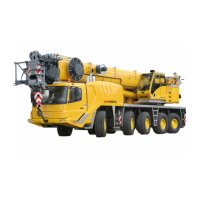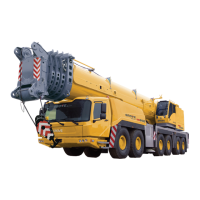OPERATING PROCEDURES GRT9165 OPERATOR MANUAL
4-20 Published 7-23-2020, Control # 668-02
General
The purpose of the differential lock is to provide maximum
traction and control on poor road or highway surfaces. When
differential locks are actuated, the clutch collar completely
locks the differential case, gearing, and axle shafts together,
maximizing traction to both wheels of each axle. The lock
position will also protect against spinout.
When normal driving conditions exist (during periods of good
traction), differential locks should not be actuated. Axles
should be allowed to operate with differential action between
both wheels.
Obey the following precautions when engaging/disengaging
the differential lock function.
1. Lock/unlock differentials only when vehicle is standing
still or moving at a constant low speed with wheels not
slipping.
2. When traveling with differentials locked, do not deviate
from a straight path more than absolutely necessary.
3. Locked differentials cause crane’s turning radius to
increase, creating an understeer condition. Use caution,
good judgment, and drive at low speeds when operating
vehicle with locked differentials.
4. Lock differentials only when maximum traction is
needed on poor road or highway surfaces.
5. Always unlock differentials when the need for maximum
traction has passed or when traveling on good road or
highway surfaces.
Operation
The differential lock function should preferably be engaged
when crane is stationary but may be engaged when moving,
if the following conditions are met:
• Crane is moving very slowly (creep speed).
• Wheels are not slipping at time of engagement.
Engage differential locks by doing the following:
NOTE: The crane control system only allows the
differential lock to be engaged for a maximum of 60
seconds at a time, regardless of whether the
Differential Lock Switch is pushed and held for a
longer time period.
1. Press and hold the Differential Lock Switch (located on
the left armrest) in the locked position with crane
stationary or moving at a slow speed.
If moving at a slow speed, let up momentarily on the
Foot Throttle Pedal to relieve torque on the differential
gearing. This will fully engage differential locks.
NOTE: When differentials are locked, the Axle Differential
Locked Indicator in the Alerts Area (1, Figure 4-74)
of the Operator Display Module (ODM) is on.
2. Proceed over poor road condition cautiously.
When adverse condition has passed, disengage differential
locks by doing the following:
1. Release the Differential Lock Switch, allowing it to return
to the unlocked position while maintaining a slow speed.
2. Let up momentarily on the Foot Throttle Pedal to relieve
torque on the differential gearing, allowing differential to
fully unlock.
NOTE: When differentials are unlocked, Axle Differential
Locked Indicator will go off.
3. Resume driving at a normal speed using good driving
judgment.
CRANING FUNCTIONS
Controller Operation
The controller operation for crane functions is proportional –
that is, the closer the lever is to neutral (center), the slower
the system responds.
NOTE: Always operate controllers with slow, even
pressure.
Proper Crane Leveling
If a crane is not level within 1% of grade, allowable capacities
must be reduced. Therefore, whether lifting on rubber or
outriggers, it is essential the crane is level to within 1% of
grade. The digital inclination indicator provided in the
Operator Display Module (ODM) is calibrated to be accurate
within 0.1% of grade.
To properly level the crane, the boom must be positioned
over front of the crane, fully lowered to horizontal and fully
retracted, and the cab must be in its fully lowered position.
Raise and level crane following instructions for Using the
Outriggers, page 4-21.
CAUTION
Possible Machine Damage!
When driving on hard, dry surfaces with differentials
locked, do not turn the wheels. Damage to drive line
components can result.
Do not lock differentials when wheels are slipping.
Damage to differentials can result.
CAUTION
Possible Loss of Vehicle Stability!
Do not lock differentials when vehicle is traveling down
steep grades and traction is minimal.

